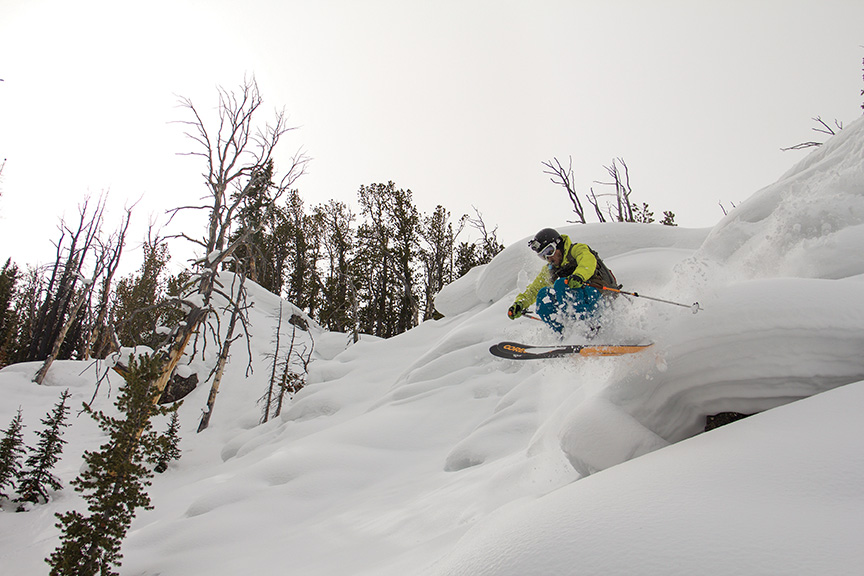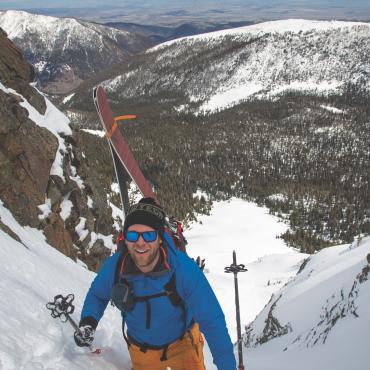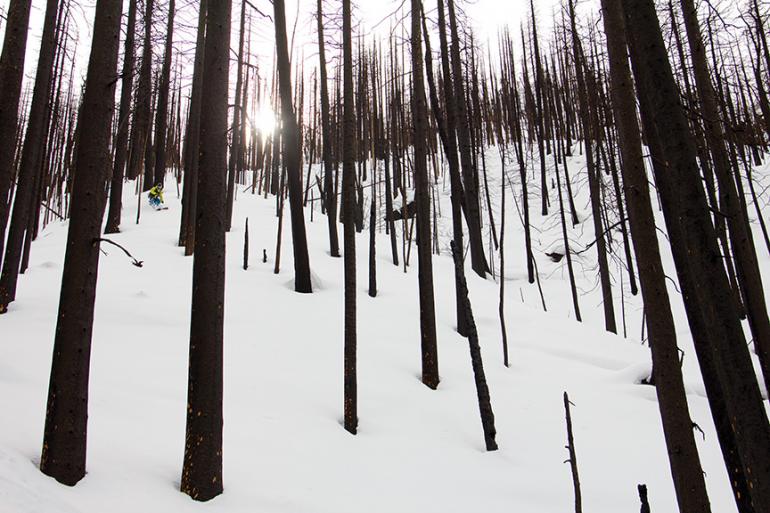Scorched Earth
Skiing the Millie burn.
It’s oddly quiet as we skin between sooty trunks, split and seared by flame. No pine boughs rustle. No branches squeak. No birds chirp. It’s still—too still, with stiff, blackened snags standing rigidly in the wind, as if seized by rigor. In the air there is a distinctive odor of char and ash swirling in contrast to the fresh, cold dampness of deep snow.
We’re 12 miles up the Storm Castle drainage, skiing what remains of a forest ravaged by the Millie Fire, which in 2012 burned more than 10,000 acres in the Gallatin National Forest south of Bozeman. Just north of us, and nearly 2,000 feet above, is the ridgeline dividing Storm Castle from South Cottonwood. The fire easily climbed the steep, wooded terrain and dropped into the head of South Cottonwood. Only intensive firefighting and luck kept the fire from jumping the next ridge into Hyalite, where it would have drastically changed the character and utility of Bozeman’s largest watershed and favorite recreation area. Likely, the effort only delayed the inevitable—Hyalite will burn one day—but it’s hard to imagine the consequences. The upshot of fires like the Millie, however, is that terrain once covered in dense timber is now chock full of ski lines.
We climb beneath blackened forest sentries. Most of the smaller branches and deadfall were incinerated, leaving plenty of space for skiers between blistered trunks. But perhaps just enough space: “Yellow clothes were a bad idea,” Steve says, after brushing a branch and coming away blackened. By the end of the day, we’ll both look like chimney sweeps. But the skiing looks phenomenal. Exposed by the flames, intricate systems of gullies wander down the steep hillside, inviting tracks, and huge tree trunks felled by fire provide ample opportunities for catching air. The few branches and snags that remain, however, are burned into surprisingly durable, spear-like points that demand caution. Impalation isn’t in our playbook, and we’re a long way from a hospital.
We climb a north-facing slope toward the high-elevation margin where dead snags meet live, unburned trees. Near the ridge, roughly 1,500 feet above where we parked the snowmobile, we’re delighted to find short pillow lines down rocky outcrops, and views of the drainage that highlight its new skiing potential. The terrain is steep, complex, and stark. It’s an open book, waiting to be read. But just getting here required a long snowmobile ride and a saw (in this and all prior experience, I’ve found that dead trees tend to fall directly onto the road whenever possible), and accessing these slopes safely requires careful consideration of the snowpack—it’s real-deal avalanche terrain. Still, the options are impressive, and this is an area that sees incredibly few skiers compared to the slopes of Mount Blackmore, for instance, which is just one canyon away. The ridge on which we stand continues south for another 700 vertical feet, to a point from which chutes and steep, sparsely treed lines drop away on northerly aspects for up to 2,500 vertical feet. But we’re antsy to ski, and the pillows and log rides look too fun to pass up, so we transition in a moment of sunshine, and get ready to drop in.

The snow is fast and energetic, and it’s hard to reel in our enthusiasm through the blackened hallways. It’s an unusual aesthetic, darting through burned forest, and one that requires attention. Live trees, with their friendly, forgiving boughs and relatively consequence-free collision policy, encourage a kind of laissez-faire skiing style. This style, I learn, is incompatible with skiing through dead snags that have been burned to a crisp. I gently brush my shoulder into a passing trunk, and am thrown nearly off my feet. But the novelty is well worth the lesson.
At the bottom, we regroup on the scorched bank of Storm Castle Creek, and contemplate another lap. We’re covered in soot, and my shoulder is sore, but the skiing was great and we’re the only skiers for miles. Why not? We may as well take advantage of what may be the only recreational benefit of a destructive fire like the Millie.










